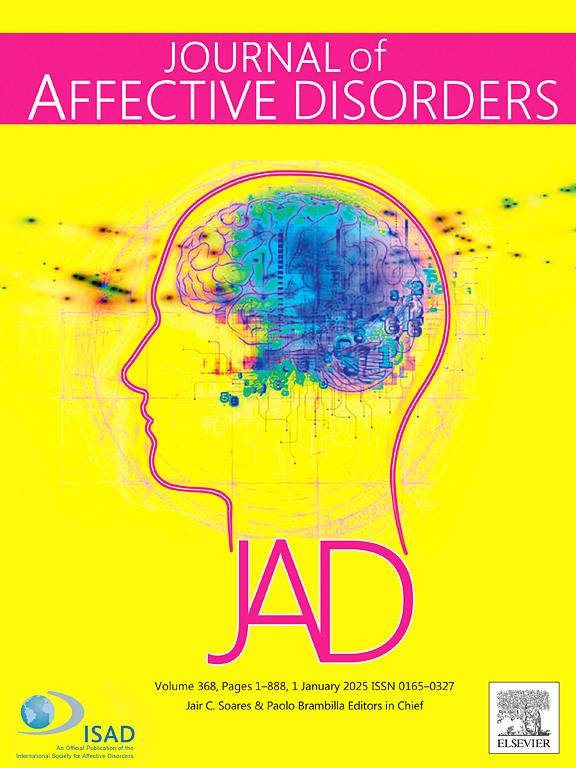预测老年认知障碍患者抑郁风险的nomogram发展与验证。
IF 4.9
2区 医学
Q1 CLINICAL NEUROLOGY
引用次数: 0
摘要
目的:开发并验证一种临床实用的预测老年认知障碍患者抑郁风险的nomogram。方法:来自2018年中国纵向健康寿命调查(CLHLS)的横断面数据包括3254名≥65 岁的成年人。以最小精神状态检查(MMSE)评分≤24分定义认知障碍;美国流行病学研究中心抑郁量表(CESD)≥10。参与者被分为训练组(n = 2278)和测试组(n = 976)。变量包括人口统计、生活方式和病史。LASSO回归(10倍交叉验证)确定了关键预测因子;多元逻辑回归构建了模态图。使用曲线下面积(AUC)、校准曲线和内部/外部验证来评估模型的性能。结果:确定了八个独立的预测因子:年轻的年龄(或 = 0.981),独自生活(或 = 1.584),吸烟史(或 = 0.650),睡眠质量差(例如,“很差”或 = 50.326),罕见的户外活动(或 = 2.272),罕见的阅读(或 = 5.558),有限电视/电台曝光(或 = 1.905),和白内障的历史(或者 = 1.587)。nomogram表现出较强的分辨力(AUC training: 0.807;检验结果:0.716)且校准良好(Hosmer-Lemeshow P = 0.491,内部验证;bootstrap MAE = 0.011确认稳定性)。结论:该图整合了认知障碍老年人抑郁风险分层的可改变的生活方式和临床因素。它的简单和准确适合资源有限的环境,使早期干预和个性化护理成为可能。局限性包括横断面设计,依赖单一数据源可能会影响测试样本之外的外部有效性,一些生活方式因素的线性假设,以及缺乏无认知障碍的抑郁个体对照组进行比较分析。本文章由计算机程序翻译,如有差异,请以英文原文为准。
Development and validation of a nomogram for predicting depression risk in older adults with cognitive impairment
Objective
To develop and validate a clinically practical nomogram for predicting depression risk in older adults with cognitive impairment.
Methods
Cross-sectional data from the 2018 Chinese Longitudinal Healthy Longevity Survey (CLHLS) included 3254 adults ≥65 years. Cognitive impairment was defined by Mini-Mental State Examination (MMSE) scores ≤24; depression by Center for Epidemiologic Studies Depression Scale (CES![]() D) ≥10. Participants were divided into training (n = 2278) and test (n = 976) sets. Variables included demographics, lifestyle, and medical history. LASSO regression (10-fold cross-validation) identified key predictors; multivariate logistic regression constructed the nomogram. Model performance was evaluated using area under the curve (AUC), calibration curves, and internal/external validation.
D) ≥10. Participants were divided into training (n = 2278) and test (n = 976) sets. Variables included demographics, lifestyle, and medical history. LASSO regression (10-fold cross-validation) identified key predictors; multivariate logistic regression constructed the nomogram. Model performance was evaluated using area under the curve (AUC), calibration curves, and internal/external validation.
Results
Eight independent predictors were identified: younger age (OR = 0.981), living alone (OR = 1.584), smoking history (OR = 0.650), poor sleep quality (e.g., “very poor” OR = 50.326), infrequent outdoor activities (OR = 2.272), rare reading (OR = 5.558), limited TV/radio exposure (OR = 1.905), and cataract history (OR = 1.587). The nomogram demonstrated strong discrimination (AUC training: 0.807; test: 0.716) and good calibration (Hosmer-Lemeshow P = 0.491, internal validation; bootstrap MAE = 0.011 confirming stability).
Conclusion
This nomogram integrates modifiable lifestyle and clinical factors for depression risk stratification in cognitively impaired older adults. Its simplicity and accuracy suit resource-limited settings, enabling early intervention and personalized care. Limitations include the cross-sectional design, reliance on a single data source which may affect external validity beyond the tested sample, the assumption of linearity for some lifestyle factors, and the absence of a control group of depressed individuals without cognitive impairment for comparative analysis.
求助全文
通过发布文献求助,成功后即可免费获取论文全文。
去求助
来源期刊

Journal of affective disorders
医学-精神病学
CiteScore
10.90
自引率
6.10%
发文量
1319
审稿时长
9.3 weeks
期刊介绍:
The Journal of Affective Disorders publishes papers concerned with affective disorders in the widest sense: depression, mania, mood spectrum, emotions and personality, anxiety and stress. It is interdisciplinary and aims to bring together different approaches for a diverse readership. Top quality papers will be accepted dealing with any aspect of affective disorders, including neuroimaging, cognitive neurosciences, genetics, molecular biology, experimental and clinical neurosciences, pharmacology, neuroimmunoendocrinology, intervention and treatment trials.
 求助内容:
求助内容: 应助结果提醒方式:
应助结果提醒方式:


